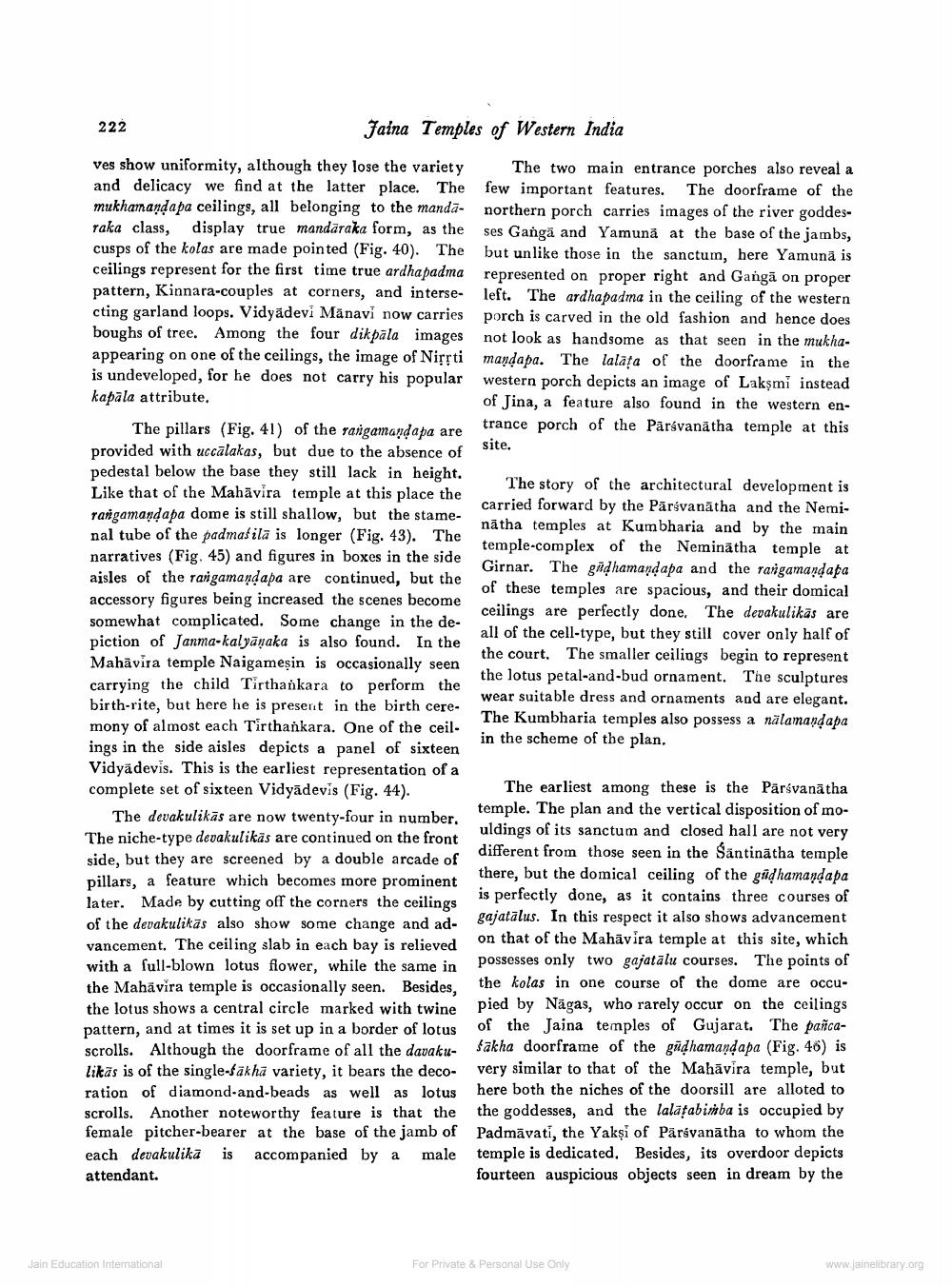________________
222
Jaina Temples of Western India
ves show uniformity, although they lose the variety The two main entrance porches also reveal a and delicacy we find at the latter place. The few important features. The doorframe of the mukhanandapa ceilings, all belonging to the mandā- northern porch carries images of the river goddesraka class, display true mandāraka form, as the ses Ganga and Yamunā at the base of the jambs, cusps of the kolas are made pointed (Fig. 40). The but unlike those in the sanctum, here Yamuna is ceilings represent for the first time true ardhapadma represented on proper right and Gangā on proper pattern, Kinnara-couples at corners, and interse- left. The ardhapadma in the ceiling of the western cting garland loops. Vidyadevi Mänavi now carries porch is carved in the old fashion and hence does boughs of tree. Among the four dikpāla images not look as handsome as that seen in the mukhaappearing on one of the ceilings, the image of Nirrti mandapa. The lalata of the doorframe in the is undeveloped, for he does not carry his popular western porch depicts an image of Lakşmi instead kapāla attribute.
of Jina, a feature also found in the western enThe pillars (Fig. 41) of the raneamandaba are trance porch of the Pārsvanātha temple at this provided with ucсālakas, but due to the absence of site, pedestal below the base they still lack in height.
The story of the architectural development is Like that of the Mahāvira temple at this place the
carried forward by the Pārsvanatha and the Nemirangamandapa dome is still shallow, but the stame
nātha temples at Kumbharia and by the main nal tube of the padmašila is longer (Fig. 43). The
temple-complex of the Neminätha temple at narratives (Fig. 45) and figures in boxes in the side
Girnar. The gadhamandapa and the rangamandapa aisles of the rangamandapa are continued, but the
of these temples are spacious, and their domical accessory figures being increased the scenes become
ceilings are perfectly done. The devakulikās are somewhat complicated. Some change in the de
all of the cell-type, but they still cover only half of piction of Janma-kalyānaka is also found. In the
the court. Mahavira temple Naigameşin is occasionally seen
The smaller ceilings begin to represent
the lotus petal-and-bud ornament. The sculptures carrying the child Tirthankara to perform the
wear suitable dress and ornaments and are elegant. birth-rite, but here he is present in the birth cere.
The Kumbharia temples also possess a nalamandapa mony of almost each Tirthankara. One of the ceil
in the scheme of the plan, ings in the side aisles depicts a panel of sixteen Vidyadevis. This is the earliest representation of a complete set of sixteen Vidyādevis (Fig. 44).
The earliest among these is the Pårsvanātha
temple. The plan and the vertical disposition of moThe devakulikās are now twenty-four in number.
uldings of its sanctum and closed hall are not very The niche-type devakulikās are continued on the front side, but they are screened by a double arcade of
different from those seen in the Säntinātha temple
there, but the domical ceiling of the güdhamaydapa pillars, a feature which becomes more prominent later. Made by cutting off the corners the ceilings
is perfectly done, as it contains three courses of of the devakulikās also show some change and ad
gajatālus. In this respect it also shows advancement vancement. The ceiling slab in each bay is relieved
on that of the Mahāvira temple at this site, which with a full-blown lotus flower, while the same in
possesses only two gajatālu courses. The points of the Mahävira temple is occasionally seen. Besides, the kolas in one course of the dome are occuthe lotus shows a central circle marked with twine pied by Nāgas, who rarely occur on the ceilings pattern, and at times it is set up in a border of lotus of the Jaina temples of Gujarat. The pañca
olls. Although the door frame of all the davaku- Sakha doorframe of the gūdhamandapa (Fig. 46) is likās is of the single-fakhā variety, it bears the deco- very similar to that of the Mahāvira temple, but ration of diamond-and-beads as well as lotus here both the niches of the doorsill are alloted to scrolls. Another noteworthy feature is that the the goddesses, and the lalatabimba is occupied by female pitcher-bearer at the base of the jamb of Padmavati, the Yakşi of Paravanatha to whom the each devakulika is accompanied by a male temple is dedicated. Besides, its overdoor depicts attendant.
fourteen auspicious objects seen in dream by the
Jain Education International
For Private & Personal use only
www.jainelibrary.org




